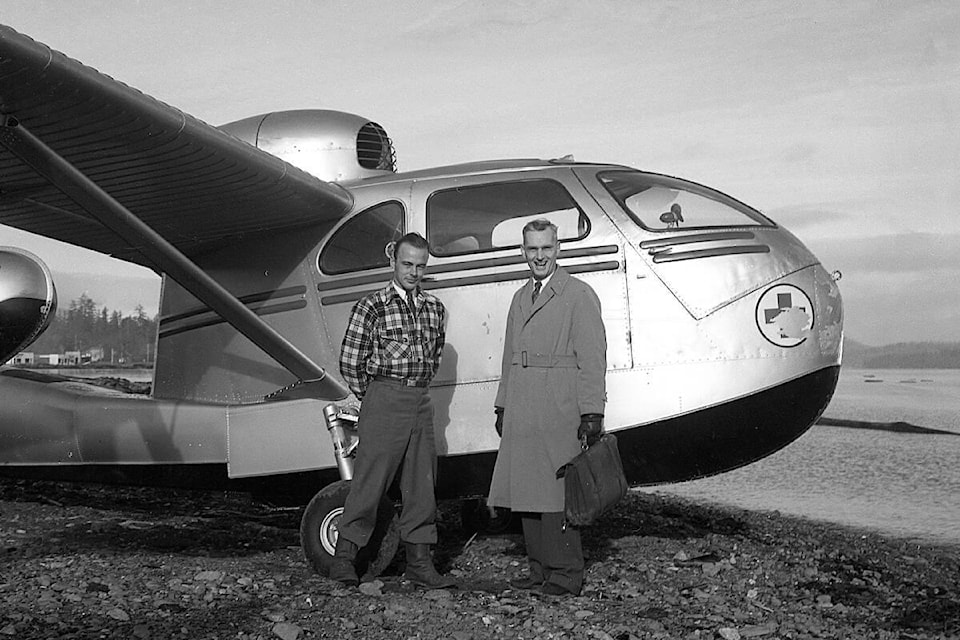Have you had the opportunity to visit the Spit and watch the seaplanes land and take-off? It may interest you to know that during the 1960s it was once regarded as the busiest seaplane base in Canada, and some would even say the world.
The first seaplane to visit Campbell River was in 1920, bringing tourists to the Willows Hotel. The demand steadily grew and soon BC Airlines was established to service this need. The SeaBee, an amphibious plane, made up most of BC Airlines fleet. The planes were stored in a field near the Willows Hotel and when needed, would be taxied across the street to the water for takeoff. The open, exposed water in Discovery Passage made for rough takeoffs and landings and many cancelled flights. The hunt for a more sheltered base began and BC Airlines negotiated with Elk River Timber to share the Tyee Spit as a new seaplane base. Operations were moved in the late 1950s.
The 1960s to 1980s saw the peak of seaplane activity in the region, with aviation flourishing during this period. Campbell River was in the middle of a huge economic boom with many small, independent logging outfits working in remote areas, as well as mining and prospecting, commercial fishing and fish packing operations all throughout the North Island region. Most of this activity was only accessible by boat or logging road, so seaplanes became a vital means of travel, bringing in equipment, crews, and residents living and working in these remote areas.
A widely recognized figure in the seaplane history of Campbell River, Bob Langdon spearheaded the development of one of the busiest companies in the industry, Island Air. At its peak, Island Air employed 50 individuals and operated 25 planes that each ran approximately 1,000 hours a year, providing services to coastal communities.
Frank Roberts of Island Air helps paint a picture of how busy the Spit was during this time. In an interview, Frank describes how the planes running out of Campbell River were close to their destinations, making an average trip last about 19 minutes. Each of Island Air’s planes would land and take off about three times an hour. That’s just for Island Air. Now imagine up to 10 seaplane companies operating out of the Spit servicing the area and you’ll start to get a picture of how busy the Spit really was.
The de Havilland Beaver, commonly known as the Workhorse of the North played a pivotal role on the coast. Pilots, like Frank Roberts, fondly described it as a “flying pick-up truck.” This rugged, versatile machine was a perfect match for challenging coastal conditions and demanding transport requirements. The Beaver was renowned for its ability to take off and land in short distances, making it an ideal choice for rough water situations. It could carry substantial loads, was economical to maintain and repair, and became an indispensable asset for the seaplane operators in the region.
Flying on the west coast presented its fair share of challenges, as pilots had to navigate treacherous and ever-changing weather conditions. Strong winds, rain, and storms were frequent occurrences in the winter, making each flight a test of skill and endurance. Jim Creighton, an Ontario bush pilot who joined Vancouver Island Air in 1988, compared flying in this region to enduring ten rounds with boxing legend Mike Tyson.
Seaplanes in Campbell River also played a role in medical emergencies, or “mercy trips” as they were known. Dr. John Ross vividly recalls a particular incident in 1962 when he received an urgent call to attend to a new mother in Gold River who was bleeding. A seaplane picked up Dr. Ross along with a lab technician to fly up to Gold River. With low overcast weather, the pilot saw a bus on a nearby logging road and made a daring landing on Elk River Estuary. The plane safely touched down on the estuary and taxied to the rocky shore where Dr. Ross and the lab technician scrambled their way up the bank, still dressed in their lab coats and suits, to flag down the bus. The bus transported them to Gold River, where they were able to match the blood type of the local loggers and provide 7 pints of blood for a transfusion. With the successful transfusion, the mother’s blood pressure stabilized, enabling her to be transported along the logging road to the hospital in Campbell River. Dr. Ross subsequently performed an operation to remove the placenta and stop the bleeding, leading to the mother’s full recovery.
This dynamic period was a significant piece of Campbell River history and is now immortalized with the newly installed monument of a Beaver floatplane frozen in flight at the Campbellton entrance to Campbell River. It stands as a reminder of the pivotal role seaplanes had in the economic development of the region.
A Look Back into the History of the Campbell River Area is a monthly presentation of the Museum at Campbell River and the Campbell River Mirror.
